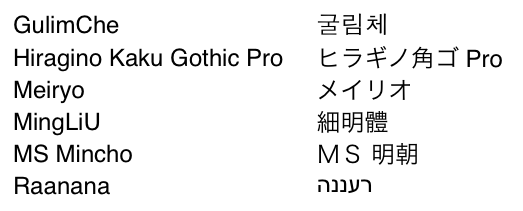
- #HOW TO REPLACE GULIM FONT PDF#
- #HOW TO REPLACE GULIM FONT SOFTWARE#
- #HOW TO REPLACE GULIM FONT CODE#
- #HOW TO REPLACE GULIM FONT WINDOWS#
The above CID and CMAP file are in the Adobe Asian font packįor Korean (ar5kitkor.exe) used with Adobe Reader 5.x.
Use the following Adobe CMAP file (maps from Unicode or local workstation codes to CID codes):. Use the following Adobe CID file (a font file):. #HOW TO REPLACE GULIM FONT PDF#
In this scenario when Host On-Demand creates the Adobe PDF file, it specifies the following
A 3270 Printer session has been configured so that:. The Korean version of Host On-Demand is running (Cp1364). The workaround is to use another print output format than Adobe PDF. Occurrences of the Euro currency symbol (Unicode 20ac) in the PDF file will When you view an Adobe PDF file that was created as the output file of aģ270 Printer session running on the Korean version of Host On-Demand, Japanese Yen and Korean Won appear as backslashes (\) on Japanese and Korean Win32 browsersīecause of a JVM problem, the following double-byte characters appear as backslashesĮuro symbol is not displayed by Adobe Reader 5.x Typing "rkrk" sends only one Korean character to Host On-Demand to be displayed instead Note: do not use the files from the JDK 1.1.6.Įven with the 1.1.5 JDK, the 3270 or 5250 broken-bar character does not display.īecause of the way the JVM composes Korean characters and the timing involved, Copy the font-property files from Sun's JDK 1.1.5 to Netscape's. If these workarounds do not work completely: Monospaced.1=\u7d30\u660e\u9ad4,CHINESEBIG5_CHARSET,NEED_CONVERTEDįontcharset.monospaced.0=sun.io.CharToByteBig5įontcharset.monospaced.1=sun.io.CharToByteBig5 Monospaced.0=\u7d30\u660e\u9ad4,CHINESEBIG5_CHARSET,NEED_CONVERTED Modify the file as follows to change the definitions for the Monospaced font from:. Monospaced.0=\uad74\ub9bc\uccb4,HANGEUL_CHARSET Monospaced.3=Symbol,SYMBOL_CHARSET,NEED_CONVERTED Monospaced.2=WingDings,SYMBOL_CHARSET,NEED_CONVERTED Modify the file as follows to change the definitions for the. Go to Netscape's \program\java\classes directory. If not, workarounds are available as follows: You might be able to solve this problem by installing the latest version of Netscape 4.06 Probably because the font-properties file is incorrect. This happens because the font used to display characters is not selected correctly, Some characters may not be displayed in the host-session screen at all, or the wrongĬharacters are displayed and the screen looks corrupted. #HOW TO REPLACE GULIM FONT WINDOWS#
On Korean and Traditional-Chinese Windows NT, with Netscape 4.06, HKEY_LOCAL_MACHINE\SOFTWARE\Microsoft\Java VM\Font Alias\Courier Korean and Traditional Chinese with Netscape 4.06 You can fix this by replacing the data for the Courier font with Gulimche (written in Korean) in the following registry entry: Microsoft Internet Explorer 4.0 does not specify the correct font for Korean. Incorrect font with Internet Explorer 4.0 on Windows NT
In the Edit String window, change Courier to the Korean font (GulLimChe: 3 Korean characters).ĭue to a platform limitation, you cannot input Korean DBCS on a Host On-Demand client running. #HOW TO REPLACE GULIM FONT SOFTWARE#
Click HKEY_LOCAL_MACHINE > SOFTWARE > MICROSOFT > Java VM > Font Alias. To avoid this problem on Microsoft Internet Explorer, edit the Windows registry. No monospaced fonts in Korean 52 sessions Sun JRE 1.4.2_03 and Netscape 7.1 on Red Hat Enterprise Linux AS 3 DBCS characters not displayed correctly with. IndexOutOfBoundsException with Korean Netscape browsers during file transfers with an iSeries. Auto IME does not accept DBCS alphanumeric input.  Auto IME and Korean Windows XP issues with Java 2. Auto Input Method Editor (IME) does not work on Korean Windows with Java 1.
Auto IME and Korean Windows XP issues with Java 2. Auto Input Method Editor (IME) does not work on Korean Windows with Java 1. #HOW TO REPLACE GULIM FONT CODE#
Euro symbol is not displayed correctly on a Windows client using code page 1364. Euro symbol is not displayed by Adobe Reader 5.x. Japanese Yen and Korean Won appear as backslashes (\) on Japanese and Korean Win32 browsers. Korean and Traditional Chinese with Netscape 4.06 on Windows NT and Windows 98. Incorrect font with Internet Explorer 4.0 on Windows NT.  No monospaced fonts in Korean 52 sessions. SimSun is listed, but MS UI Gothic and YaHei has those characters.The following problems have been encountered with Host On-Demand running in a Korean language environment: I looked into the registry at Computer\HKEY_LOCAL_MACHINE\SOFTWARE\Microsoft\Windows NT\CurrentVersion\FontLink\SystemLinkĪnd Segoe UI has correct entry: TAHOMA.TTF,Tahoma The actual fonts used for rendering are "MS Mincho" for hiragana and "SimSun" for kanji.
No monospaced fonts in Korean 52 sessions. SimSun is listed, but MS UI Gothic and YaHei has those characters.The following problems have been encountered with Host On-Demand running in a Korean language environment: I looked into the registry at Computer\HKEY_LOCAL_MACHINE\SOFTWARE\Microsoft\Windows NT\CurrentVersion\FontLink\SystemLinkĪnd Segoe UI has correct entry: TAHOMA.TTF,Tahoma The actual fonts used for rendering are "MS Mincho" for hiragana and "SimSun" for kanji. 
The requested font (selected in the App UI), is Segoe UI. If I set my display language to Japanese, logout and log back in, the problem is gone. The font used for kanji is a Chinese one and it looks really weird, especially at small sizes where it is not anti-aliased. Some applications are showing a strange behaviour when rendering Japanese fonts.







 0 kommentar(er)
0 kommentar(er)
